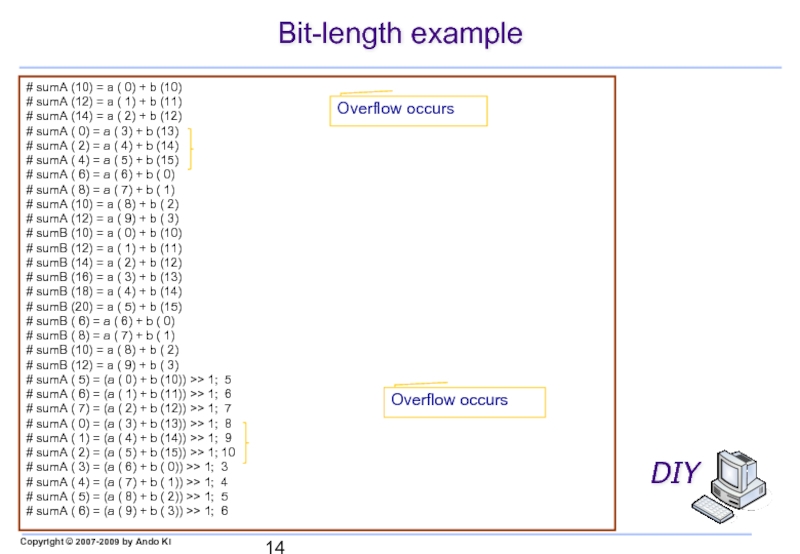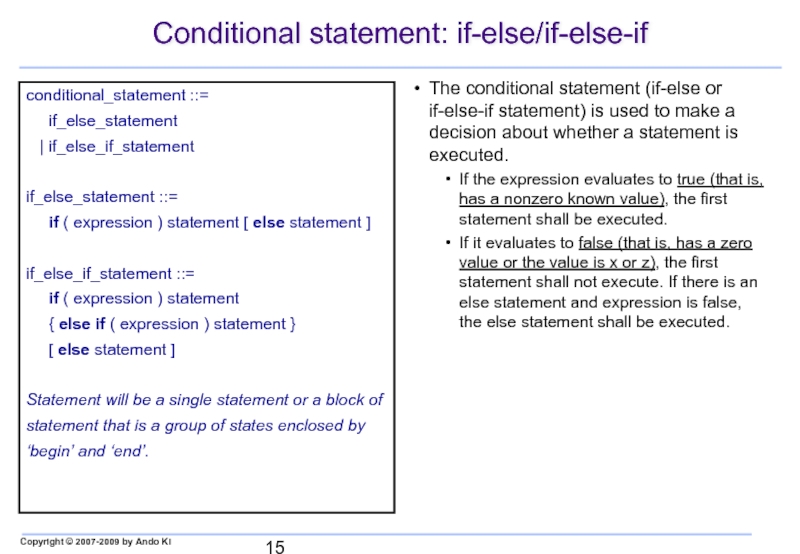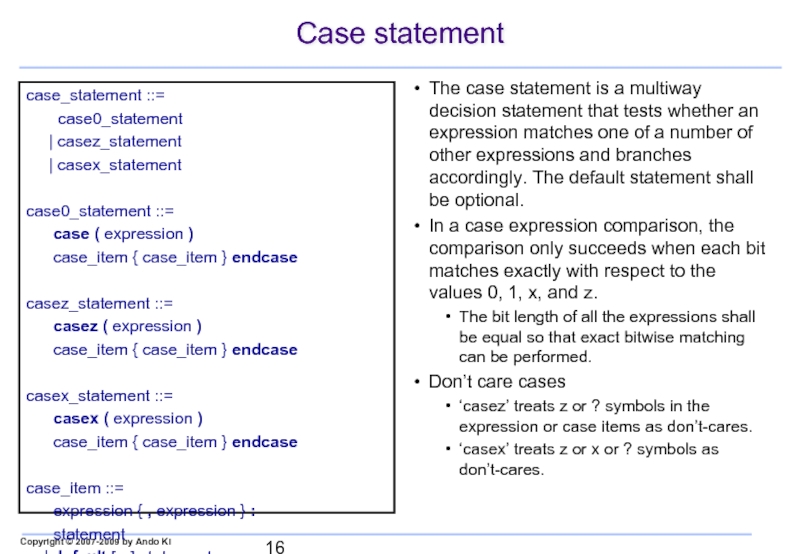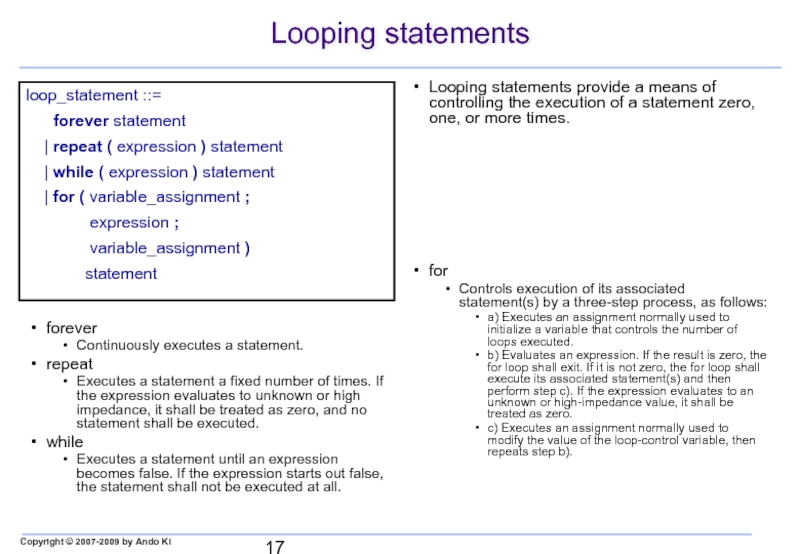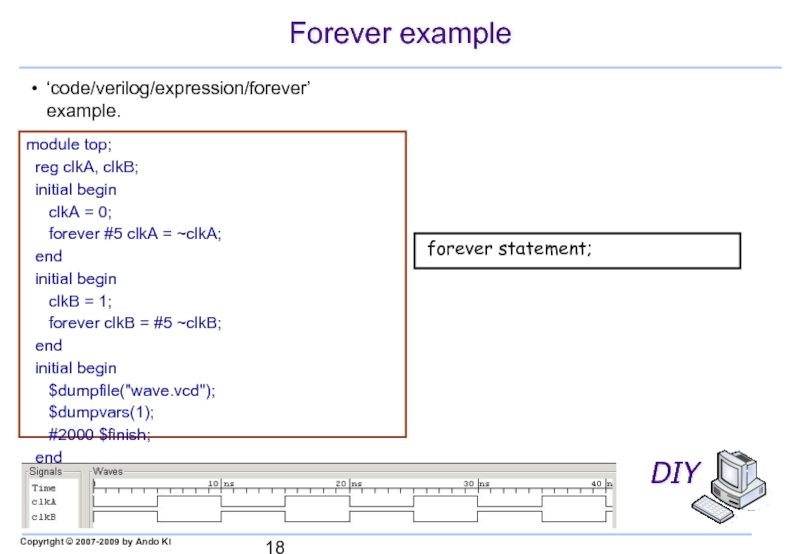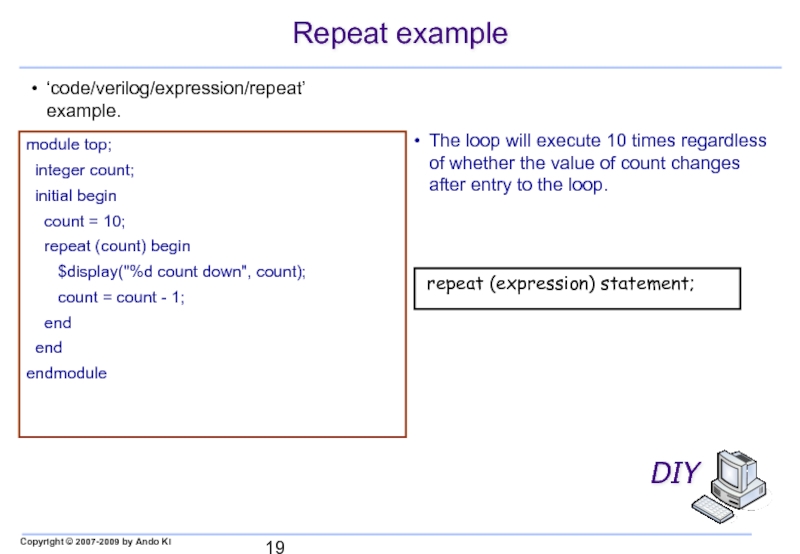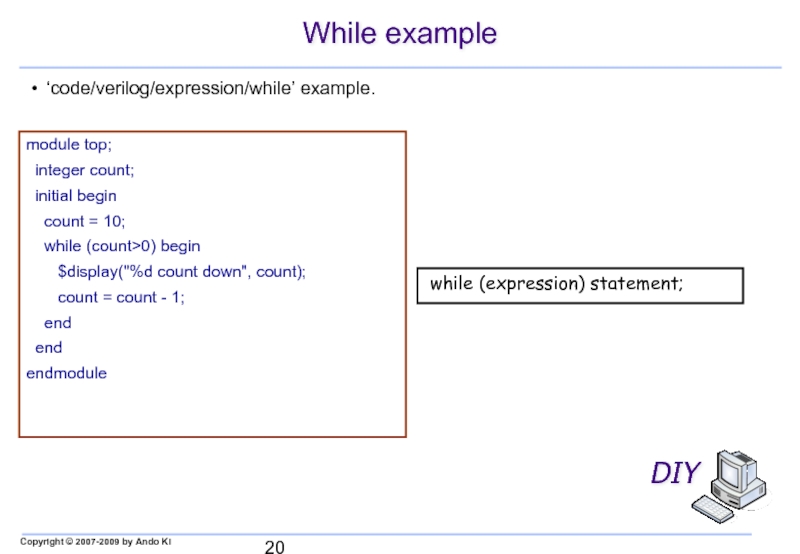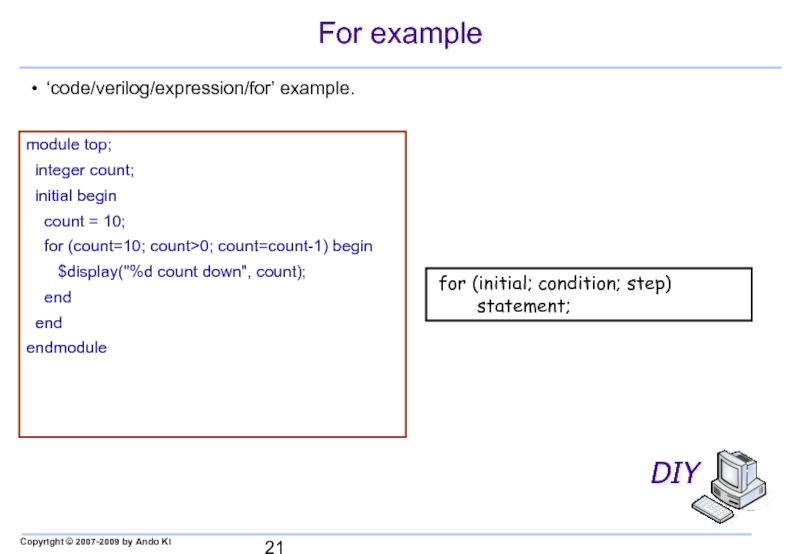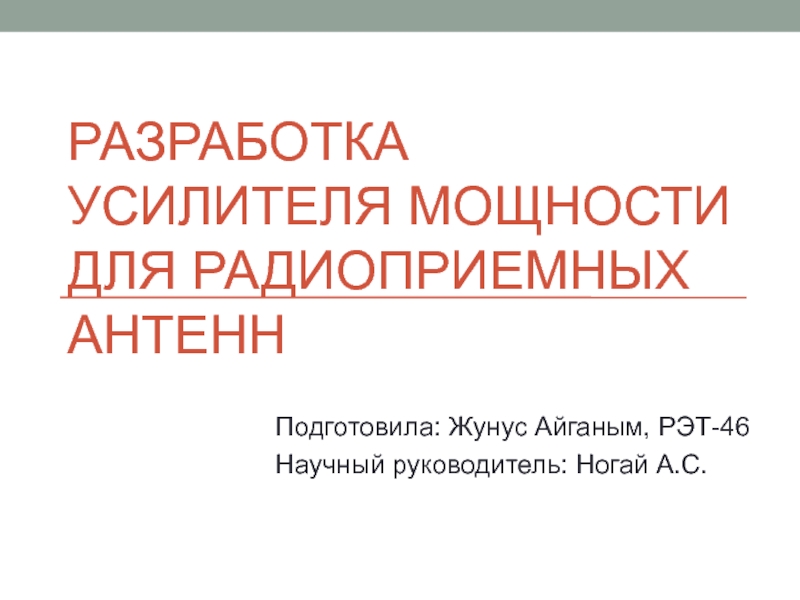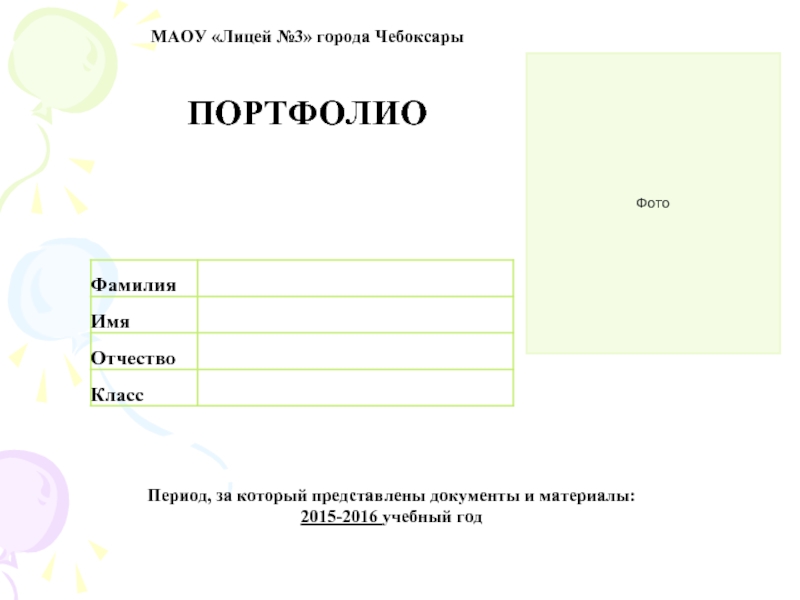- Главная
- Разное
- Дизайн
- Бизнес и предпринимательство
- Аналитика
- Образование
- Развлечения
- Красота и здоровье
- Финансы
- Государство
- Путешествия
- Спорт
- Недвижимость
- Армия
- Графика
- Культурология
- Еда и кулинария
- Лингвистика
- Английский язык
- Астрономия
- Алгебра
- Биология
- География
- Детские презентации
- Информатика
- История
- Литература
- Маркетинг
- Математика
- Медицина
- Менеджмент
- Музыка
- МХК
- Немецкий язык
- ОБЖ
- Обществознание
- Окружающий мир
- Педагогика
- Русский язык
- Технология
- Физика
- Философия
- Химия
- Шаблоны, картинки для презентаций
- Экология
- Экономика
- Юриспруденция
Verilog- Operator, operand, expression and control - презентация
Содержание
- 1. Verilog- Operator, operand, expression and control -
- 2. Contents Expression Operand Operator Bitwise and reduction
- 3. Verilog expression Verilog expression combines operands with
- 4. Verilog operand signed and unsigned constant
- 5. Verilog operator (1/2)
- 6. Verilog operator (2/2) Logical operators: &&, ||,
- 7. Bit-wise and reduction operators Bit-wise binary AND
- 8. Concatenation and replication example module top;
- 9. Sign example (1/2) module top; integer
- 10. Sign example (2/2) intA
- 11. Shift example module top; reg
- 12. Expression bit-length The Verilog uses the bit
- 13. Bit-length example module top; reg
- 14. Bit-length example # sumA (10) = a
- 15. Conditional statement: if-else/if-else-if The conditional statement (if-else
- 16. Case statement The case statement is a
- 17. Looping statements forever Continuously executes a statement.
- 18. Forever example module top; reg clkA,
- 19. Repeat example module top; integer count;
- 20. While example module top; integer count;
- 21. For example module top; integer count;
Слайд 2Contents
Expression
Operand
Operator
Bitwise and reduction operators
Concatenation and replication example
Sign example
Shift example
Expression bit-length
Bit-length example
Conditional
if-else/if-else-if
case
Looping statements
forever example
repeat example
while example
for example
control & conditional constructs
if-else/if-else-if
case
looping
repeat
for
while
forever
Слайд 3Verilog expression
Verilog expression combines operands with operators to produce a result.
Scalar
The least significant bit of the result is used when the expression results in multi-bit.
expression ::= primary
| unary_operator { attribute_instance } primary
| expression binary_operator { attribute_instance } expression
| conditional_expression
primary ::= number
| hierarchical_identifier [ { [ expression ] } [ range_expression ] ]
| concatenation | multiple_concatenation
| function_call | system_function_call
| ( mintypmax_expression ) | string
Слайд 4Verilog operand
signed and unsigned constant
An integer with no base specification shall
12 and -12
An integer with an unsigned base specification shall be interpreted as unsigned value.
‘d12
-’d12 == -32’d12 == FFFFFFF4
Sign base should be used for signed integer.
-’sd12
or –’SD12
Verilog operand
Constant number including real
Net
Variables of type reg, integer, time, real, and realtime
Net bit-select
Bit-select of type reg, integer, and time
Net part-select
Part-select of type reg, integer, and time
Array element (not whole array)
A call to a user-defined function or system-function that returns any of the above
Слайд 6Verilog operator (2/2)
Logical operators: &&, ||, !
Result in one bit value
Bitwise
Operation on bit by bit basis
Reduction operators (prefix): &, |, ^, ~&, ~|, ~^
Result in one bit value
Logical shift operators: >>, <<
Result in the same size, always fills zero
Concatenation operators: {, }
Replication: {n{X}}
Relational operators: >, <, >=, <=
Result in one bit value
Logical equality operators: ==, !=
Result in either true or false
Case equality operators: ===, !==
Exact match including X/x and Z/z
Conditional operators: ? :
Like 2-to-1 mux
Arithmetic/math operators: +, -, *, /, %
If any operand is x the result is x.
Unary: +, -
Слайд 7Bit-wise and reduction operators
Bit-wise binary AND
Bit-wise binary OR
Bit-wise binary XOR
Bit-wise binary
Bit-wise unary negation
Unary reduction example
Слайд 8Concatenation and replication example
module top;
reg a;
reg [3:0] c;
reg [6:0] d;
reg [9:0] e;
initial begin
a = 1'b1;
b = 2'b01;
c = {4{a}}; // replication of 1’b1
d = {3{b}}; // replication of 2’b01
e = {b, c, b}; // concatenation
$display("a=%b b=%b c=%b d=%b e=%b", a, b, c, d, e);
end
endmodule
‘code/verilog/expression/replicate’ example.
# a=1 b=01 c=1111 d=0010101 e=0001111101
Слайд 9Sign example (1/2)
module top;
integer intA,
reg [15:0] regA, regB, regC;
reg signed [15:0] regSA, regSB;
initial begin
intA = -12 / 3; // The result is -4.
intB = -'d 12 / 3; // The result is 1431655761.
intC = -'sd 12 / 3; // The result is -4.
intD = -4'sd 12 / 3; // -4'sd12 is the negative of the 4-bit
// quantity 1100, which is -4. -(-4) = 4.
// The result is 1.
$display("intA : -12 / 3 => %d 0x%h", intA, intA);
$display("intB : -'d 12 / 3 => %d 0x%h", intB, intB);
$display("intC : -'sd 12 / 3 => %d 0x%h", intC, intC);
$display("intD : -4'sd 12 / 3 => %d 0x%h", intD, intD);
//-----------------------------------------------------
‘code/verilog/expression/sign’ example.
Слайд 10Sign example (2/2)
intA = -4'd12;
regA = intA / 3; // expression result is -4,
// intA is an integer data type, regA is 65532
regB = -4'd12; // regB is 65524
intB = regB / 3; // expression result is 21841,
// regB is a reg data type
intC = -4'd12 / 3; // expression result is 1431655761.
// -4'd12 is effectively a 32-bit reg data type
regC = -12 / 3; // expression result is -4, -12 is effectively
// an integer data type. regC is 65532
regSA = -12 / 3; // expression result is -4. regSA is a signed reg
regSB = -4'sd12 / 3; // expression result is 1. -4'sd12 is actually 4.
$display("intA : -4'd12 => %d 0x%h", intA, intA);
$display("regA : intA / 3 => %d 0x%h", regA, regA);
$display("regB : -4'd12 => %d 0x%h", regB, regB);
$display("intB : regB / 3 => %d 0x%h", intB, intB);
$display("intC : -4'd12 / 3 => %d 0x%h", intC, intC);
$display("regC : -12 / 3 => %d 0x%h", regC, regC);
$display("regSA : -12 / 3 => %d 0x%h", regSA, regSA);
$display("regSB : -4'sd12 / 3 => %d 0x%h", regSB, regSB);
end
endmodule
‘code/verilog/expression/sign’ example.
# intA : -12 / 3 => -4 0xfffffffc
# intB : -'d 12 / 3 => 1431655761 0x55555551
# intC : -'sd 12 / 3 => -4 0xfffffffc
# intD : -4'sd 12 / 3 => 1 0x00000001
# intA : -4'd12 => -12 0xfffffff4
# regA : intA / 3 => 65532 0xfffc
# regB : -4'd12 => 65524 0xfff4
# intB : regB / 3 => 21841 0x00005551
# intC : -4'd12 / 3 => 1431655761 0x55555551
# regC : -12 / 3 => 65532 0xfffc
# regSA : -12 / 3 => -4 0xfffc
# regSB : -4'sd12 / 3 => 1 0x0001
Слайд 11Shift example
module top;
reg
reg signed [3:0] valueA, resultA, resultAS;
initial begin
valueL = 4'b1000;
resultL = (valueL >> 2);
resultLS = (valueL >>> 2); // be careful
valueA = 4'b1000;
resultA = (valueA >> 2); // be careful
resultAS = (valueA >>> 2);
//----------------------------------
$display("valueL : %d 0x%h", valueL, valueL);
$display("resultL : (valueL >> 2) ==> %d 0x%h", resultL, resultL);
$display("resultLS : (valueL >>> 2) ==> %d 0x%h", resultLS, resultLS);
$display("valueA : %d 0x%h", valueA, valueA);
$display("resultA : (valueA >> 2) ==> %d 0x%h", resultA, resultA);
$display("resultAS : (valueA >>> 2) ==> %d 0x%h", resultAS, resultAS);
end
endmodule
‘code/verilog/expression/shift’ example.
# valueL : 8 0x8
# resultL : (valueL >> 2) ==> 2 0x2
# resultLS : (valueL >>> 2) ==> 2 0x2
# valueA : -8 0x8
# resultA : (valueA >> 2) ==> 2 0x2
# resultAS : (valueA >>> 2) ==> -2 0xe
Слайд 12Expression bit-length
The Verilog uses the bit length of the operands to
reg [15:0] a, b; // 16-bit regs
reg [15:0] sumA; // 16-bit reg
reg [16:0] sumB; // 17-bit reg
sumA = a + b; // expression evaluates using 16 bits
// it can lose carry overflow.
sumB = a + b; // expression evaluates using 17 bits
sumA = (a+b)>>1; // will not work properly
Слайд 13Bit-length example
module top;
reg [3:0] a, b, sumA;
reg
initial begin
b = 10;
for (a=0; a<10; a=a+1) begin
sumA = a + b;
$display("sumA (%d) = a (%d) + b (%d)", sumA, a, b);
b = b + 1;
end
b = 10;
for (a=0; a<10; a=a+1) begin
sumB = a + b;
$display("sumB (%d) = a (%d) + b (%d)", sumB, a, b);
b = b + 1;
end
b = 10;
for (a=0; a<10; a=a+1) begin
sumA = (a + b)>>1; // incorrect result
sumB = (a + b)>>1; // correct result
$display("sumA (%d) = (a (%d) + b (%d)) >> 1; %d", sumA, a, b, sumB);
b = b + 1;
end
end
endmodule
‘code/verilog/expression/bitlength’ example.
Слайд 14Bit-length example
# sumA (10) = a ( 0) + b (10)
#
# sumA (14) = a ( 2) + b (12)
# sumA ( 0) = a ( 3) + b (13)
# sumA ( 2) = a ( 4) + b (14)
# sumA ( 4) = a ( 5) + b (15)
# sumA ( 6) = a ( 6) + b ( 0)
# sumA ( 8) = a ( 7) + b ( 1)
# sumA (10) = a ( 8) + b ( 2)
# sumA (12) = a ( 9) + b ( 3)
# sumB (10) = a ( 0) + b (10)
# sumB (12) = a ( 1) + b (11)
# sumB (14) = a ( 2) + b (12)
# sumB (16) = a ( 3) + b (13)
# sumB (18) = a ( 4) + b (14)
# sumB (20) = a ( 5) + b (15)
# sumB ( 6) = a ( 6) + b ( 0)
# sumB ( 8) = a ( 7) + b ( 1)
# sumB (10) = a ( 8) + b ( 2)
# sumB (12) = a ( 9) + b ( 3)
# sumA ( 5) = (a ( 0) + b (10)) >> 1; 5
# sumA ( 6) = (a ( 1) + b (11)) >> 1; 6
# sumA ( 7) = (a ( 2) + b (12)) >> 1; 7
# sumA ( 0) = (a ( 3) + b (13)) >> 1; 8
# sumA ( 1) = (a ( 4) + b (14)) >> 1; 9
# sumA ( 2) = (a ( 5) + b (15)) >> 1; 10
# sumA ( 3) = (a ( 6) + b ( 0)) >> 1; 3
# sumA ( 4) = (a ( 7) + b ( 1)) >> 1; 4
# sumA ( 5) = (a ( 8) + b ( 2)) >> 1; 5
# sumA ( 6) = (a ( 9) + b ( 3)) >> 1; 6
Overflow occurs
Overflow occurs
Слайд 15Conditional statement: if-else/if-else-if
The conditional statement (if-else or if-else-if statement) is used
If the expression evaluates to true (that is, has a nonzero known value), the first statement shall be executed.
If it evaluates to false (that is, has a zero value or the value is x or z), the first statement shall not execute. If there is an else statement and expression is false, the else statement shall be executed.
conditional_statement ::=
if_else_statement
| if_else_if_statement
if_else_statement ::=
if ( expression ) statement [ else statement ]
if_else_if_statement ::=
if ( expression ) statement
{ else if ( expression ) statement }
[ else statement ]
Statement will be a single statement or a block of statement that is a group of states enclosed by ‘begin’ and ‘end’.
Слайд 16Case statement
The case statement is a multiway decision statement that tests
In a case expression comparison, the comparison only succeeds when each bit matches exactly with respect to the values 0, 1, x, and z.
The bit length of all the expressions shall be equal so that exact bitwise matching can be performed.
Don’t care cases
‘casez’ treats z or ? symbols in the expression or case items as don’t-cares.
‘casex’ treats z or x or ? symbols as don’t-cares.
case_statement ::=
case0_statement
| casez_statement
| casex_statement
case0_statement ::=
case ( expression )
case_item { case_item } endcase
casez_statement ::=
casez ( expression )
case_item { case_item } endcase
casex_statement ::=
casex ( expression )
case_item { case_item } endcase
case_item ::=
expression { , expression } :
statement
| default [ : ] statement
Слайд 17Looping statements
forever
Continuously executes a statement.
repeat
Executes a statement a fixed number of
while
Executes a statement until an expression becomes false. If the expression starts out false, the statement shall not be executed at all.
Looping statements provide a means of controlling the execution of a statement zero, one, or more times.
for
Controls execution of its associated statement(s) by a three-step process, as follows:
a) Executes an assignment normally used to initialize a variable that controls the number of loops executed.
b) Evaluates an expression. If the result is zero, the for loop shall exit. If it is not zero, the for loop shall execute its associated statement(s) and then perform step c). If the expression evaluates to an unknown or high-impedance value, it shall be treated as zero.
c) Executes an assignment normally used to modify the value of the loop-control variable, then repeats step b).
loop_statement ::=
forever statement
| repeat ( expression ) statement
| while ( expression ) statement
| for ( variable_assignment ;
expression ;
variable_assignment )
statement
Слайд 18Forever example
module top;
reg clkA, clkB;
initial begin
clkA
forever #5 clkA = ~clkA;
end
initial begin
clkB = 1;
forever clkB = #5 ~clkB;
end
initial begin
$dumpfile("wave.vcd");
$dumpvars(1);
#2000 $finish;
end
endmodule
‘code/verilog/expression/forever’ example.
forever statement;
Слайд 19Repeat example
module top;
integer count;
initial begin
count = 10;
$display("%d count down", count);
count = count - 1;
end
end
endmodule
‘code/verilog/expression/repeat’ example.
The loop will execute 10 times regardless of whether the value of count changes after entry to the loop.
repeat (expression) statement;
Слайд 20While example
module top;
integer count;
initial begin
count = 10;
$display("%d count down", count);
count = count - 1;
end
end
endmodule
‘code/verilog/expression/while’ example.
while (expression) statement;
Слайд 21For example
module top;
integer count;
initial begin
count = 10;
$display("%d count down", count);
end
end
endmodule
‘code/verilog/expression/for’ example.
for (initial; condition; step)
statement;
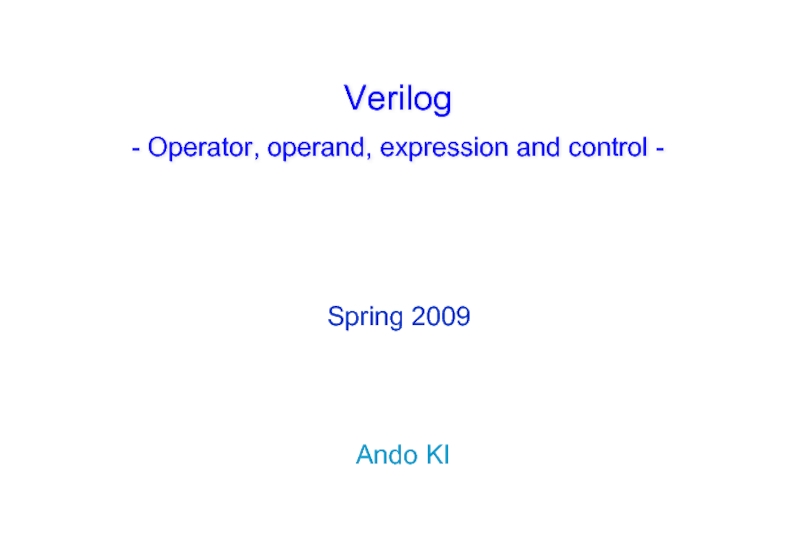
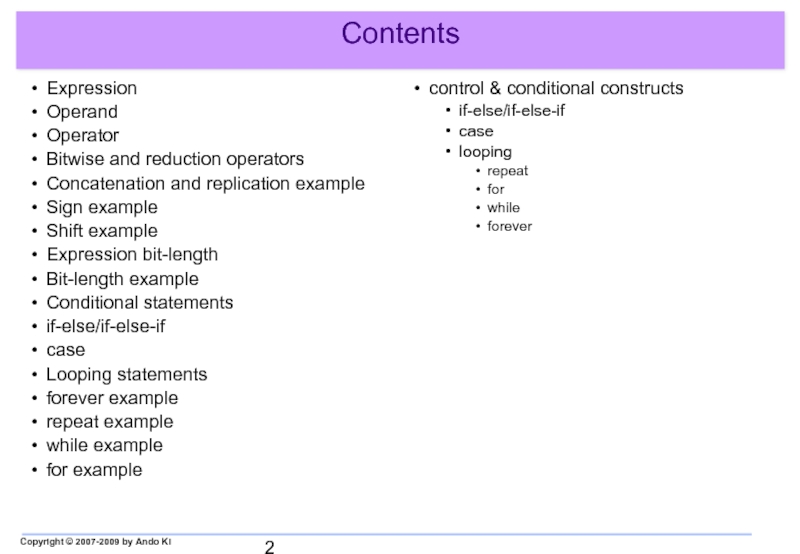
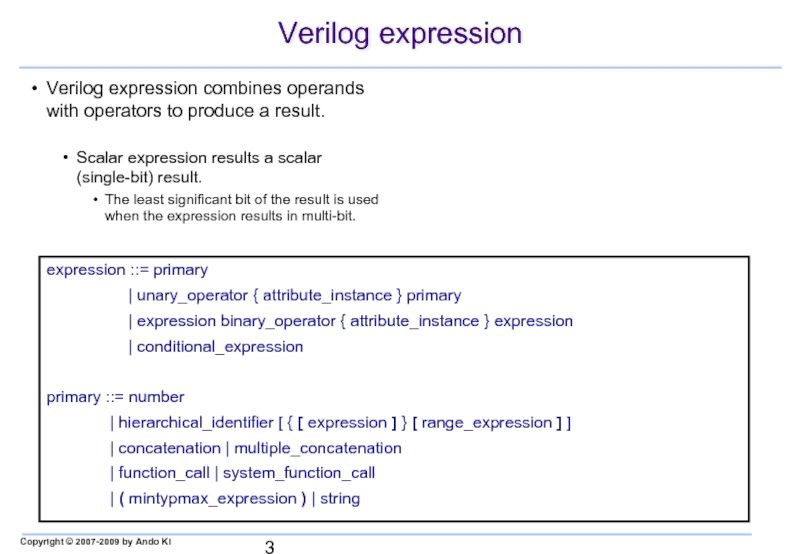
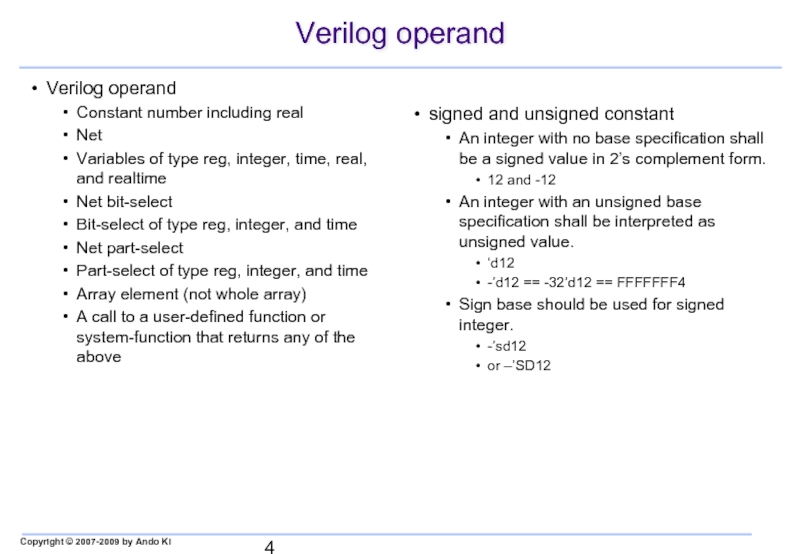
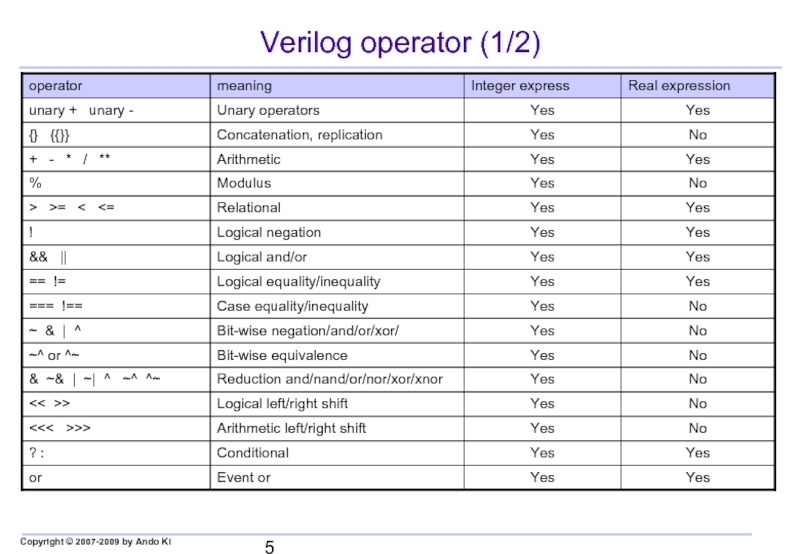
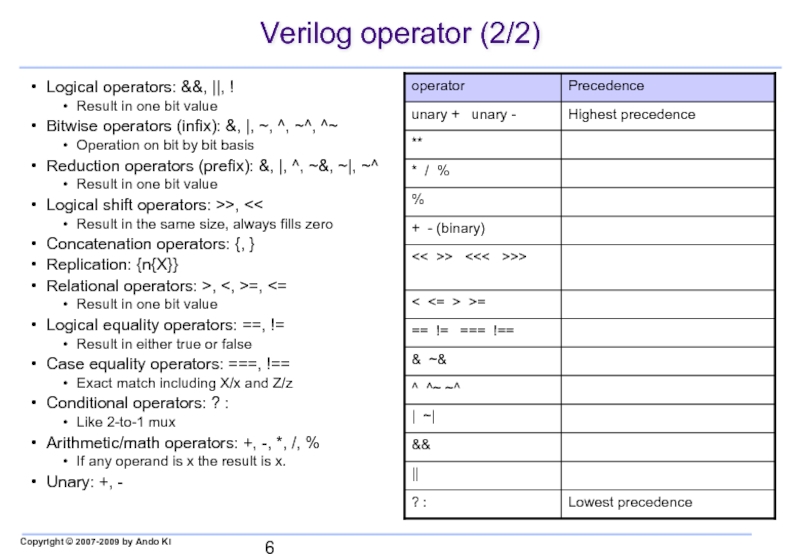
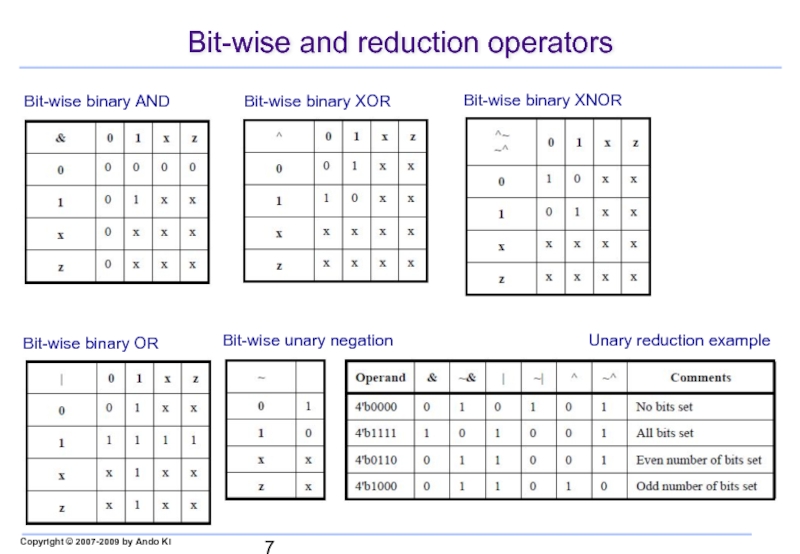
![Concatenation and replication examplemodule top; reg a; reg [1:0] b; reg [3:0] c; reg](/img/tmb/2/118030/0746a6a5aebe543d995575e73ab4ed2b-800x.jpg)
![Sign example (1/2)module top; integer intA, intB, intC, intD; reg [15:0] regA,](/img/tmb/2/118030/b94533f05c70eedc6eea29d28a501b3b-800x.jpg)
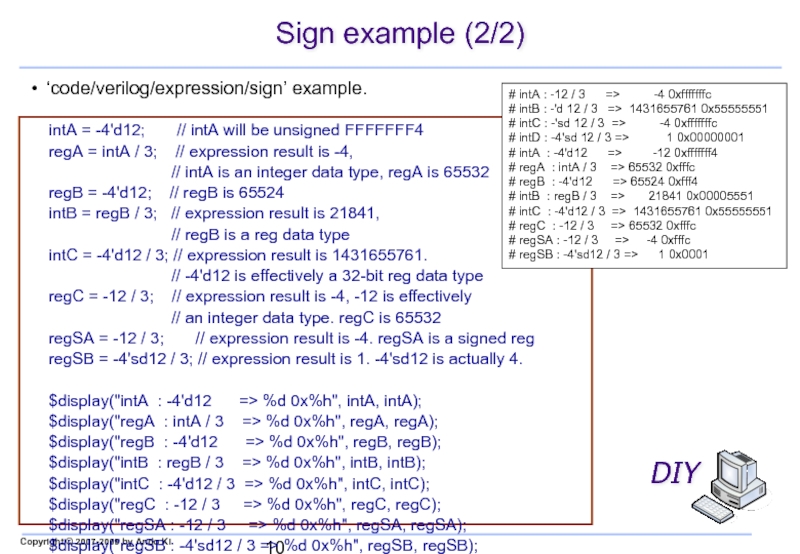
![Shift examplemodule top; reg [3:0] valueL, resultL, resultLS; reg signed [3:0] valueA,](/img/tmb/2/118030/2187ac200d348d277315d385c51aa499-800x.jpg)
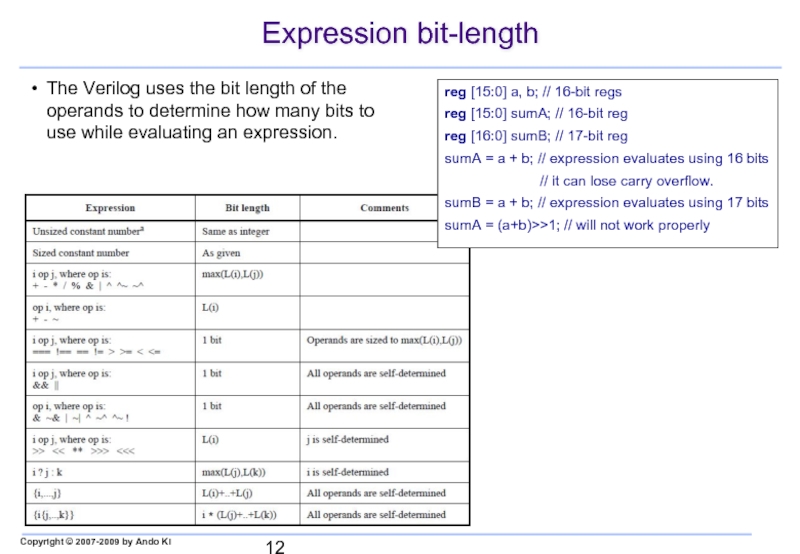
![Bit-length examplemodule top; reg [3:0] a, b, sumA; reg [4:0] sumB; initial begin b](/img/tmb/2/118030/3dc1c722fbba6363589dea87a1242220-800x.jpg)
